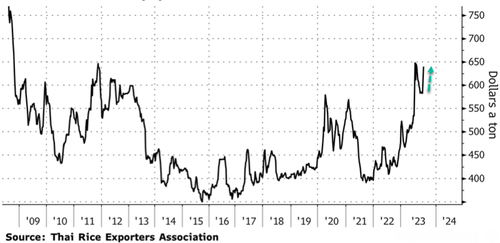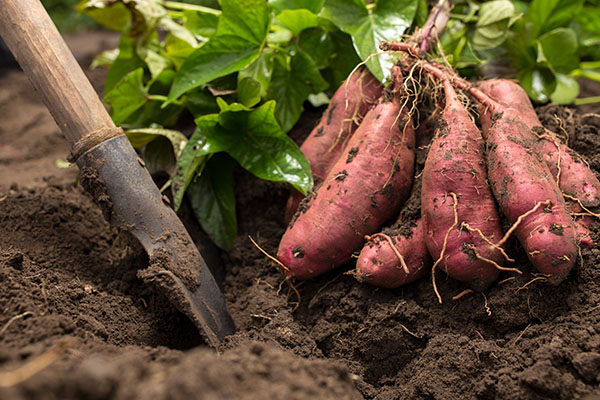El Nino sends rice prices soaring, nearly reaching new 15-year peak
12/06/2023 / By Belle Carter

Experts are expecting rice prices to reach a new 15-year high in the aftermath of the El Nino weather phenomenon – a large-scale oceanographic/meteorological phenomenon associated with extreme climatic variability i.e., devastating rains, winds, drought, etc. – across Asia that has damaged farmlands and massively affected the supply chain.
Thai white rice five percent broken (an Asian benchmark) has jumped by $57 over the past two weeks to $640 a ton following a period of relative calm, putting prices just short of the highest level since October 2008. Prices are up over 50 percent since the start of 2022.

Increased demand for Thai rice from unexpected buyers such as Brazil and the Philippines has contributed to the rise, according to Chookiat Ophaswongse, an honorary president of the Thai Rice Exporters Association. Higher domestic prices and a strengthening of the baht have helped to underpin the surge, he further told Bloomberg. He said prices are being pushed up as top producer countries run low on supplies and demand increases elsewhere. “We’re selling well now because Vietnam is low on stocks,” said Chookiat.
Production of rice in Brazil was forecasted to reach approximately 10.6 million metric tons in crop year 2021-2022, a decrease from the 10.45 million tons of the previous crop year. Meanwhile, the volume of unmilled rice produced in the Philippines amounted to around 19.76 million metric tons in 2022. “Palay” production has fluctuated in the country since 2012. Also, the production volume of rice paddies in Vietnam amounted to approximately 42.7 million metric tons last year, indicating a decrease compared to 2021.
The panic on shortage thus skyrocketing prices started earlier this year, when India decided to ban certain rice exports in July. India is the world’s largest rice exporter, accounting for up to 40 percent of rice on the world market. The rice trade declined after the announcement. (Related: India BANS exports of non-basmati white rice amid rapid inflation and global rice panic.)
Rice export stopped from India and massive panick hit the Indians in USA. Hoarding has started across the states. There has been multiple food shortages here, hoping rice shortage doesn’t get added to the list. pic.twitter.com/vdP6NBwrN6
— The Thinking Hat ?? (@ThinkinHashtag) July 21, 2023
Some supermarkets in the United States have responded to this announcement by implementing purchase limits, while others have hiked prices. Videos circulated on social media showing how customers were panic buying amid concerns of a global shortage, which is reminiscent of the 2008 Asian food price scare.
The onset of El Nino, which typically brings drier conditions to growing areas in Asia, is poised to crimp supply even further. Thailand’s production is forecasted to decline six percent in 2023-24 due to the climate phenomenon, while Vietnam directed some farmers to plant their new crops early warning of drought risks.
Prices to rule firm in 2024 as India continues to curb rice exports: experts
Rice prices in the global market are likely to rule firm until mid-2024 with India’s export curbs expected to last, at least, until its Parliament elections in April-May 2024 and El Nino risks supporting the uptrend. As per research agency BMI Research, a unit of Fitch Solutions, “It is our view that India’s rice export restrictions will remain in effect until after the April-May legislative elections at the earliest, which will support prices at recent levels as will El Nino risks.”
Meanwhile, according to the Food and Agriculture Organization’s Cereal Supply and Demand Brief, the international trade in rice in 2024 will likely be 52.8 million tons, close to the 2023 reduced level. This is due to “lower foreseen purchases, namely from Indonesia and various Eastern African countries, that could offset likely import increases by few Far-Eastern importers, the European Union and various Latin American countries,” the brief said.
“We forecast that the global rice sector will generate its third consecutive deficit in 2023-24, albeit one less than half the size of the estimated 2022-23 shortfall,” BMI stated, adding that the world stocks-to-forecasted-consumption ratio is set to remain higher than 30 percent. “We hold unchanged at $16.80 per cwt (centum weight), our average rice price forecast for 2023.”
BMI has made an upward revision of the rice price forecast from $15.50 per cwt to $15.95 per cwt to its average price forecast for CBOT-listed second-month rough rice futures in 2024. Rice prices in the global market will likely be firm as New Delhi continues with its export curbs, experts said. Thailand’s Cabinet approved a 55 billion baht (around $1.57 billion) scheme for farmers to hold back their paddy for at least five months.
Discover more about the dwindling global food supply on FoodCollapse.com.
Sources for this article include:
Submit a correction >>
Tagged Under:
Asia, Climate, Collapse, crops, damaged farmlands, El Nino, export, famine, food collapse, food crisis, food supply, harvest, India, inflation, non-basmati, rice, rice prices, shortage, starvation, supply chain, Thai Rice Exporters Association, weather phenomenon, weather terrorism, world agriculture
This article may contain statements that reflect the opinion of the author
RECENT NEWS & ARTICLES
COPYRIGHT © 2017 FOOD SCIENCE NEWS



















